Carob-Coconut Oil Bars for CLL
Posted by: Denise on: May 4, 2016
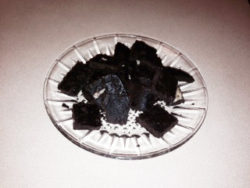
Carob Bars for CLL
I’ve been asked by a few of my CLL buddies to share some of the recipes I use in my daily life—in my quest for optimal health. One of the items I make at least each week, and eat nearly every single day are Carob-Coconut Bars. Coconut oil is a natural for anyone trying to improve their immune system. It fights nearly all pathogens (germs), including viruses, bacteria, and protozoa. There is documentation on youtube.com about its ability to improve Alzheimer disease, and perhaps prevent it.
The problem is that coconut oil is kind of tough to eat on its own. Personally, I’m not that fond of the coconut taste. But the good news is that the taste of carob is a bit stronger than the coconut flavor, and carob has its own natural sweetness, so no need to add any natural sweetener to make it palatable.  (I first tried making this with powdered chocolate, and found it was awful without sweetener.)
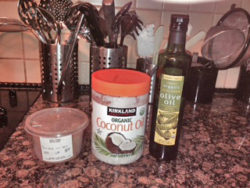
Ingredients:
The ingredients are:
Coconut Oil (I buy organic from Costco)
Carob Powder (I buy from my local health food store)
Olive Oil (organic, cold-pressed from Trader Joe’s)
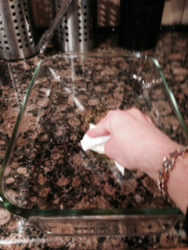
Olive Oil on lasagna pan.
Pour a tablespoon or so of the organic olive oil into a lasagna pan. This is so that the carob bars will be easier to remove from the pan when done.  I wasn’t specific about the quantity of each of the ingredients. This is because all you need to do is use equal amounts of coconut oil and carob powder. I buy carob in plastic containers at one of our local health-food markets. I wash them when empty and use them to measure the amount of coconut oil to use the next time. So, think 2 cups coconut oil to 2 cups carob powder. Simple!!!
A tricky thing, though, is that coconut oil is a solid, unless it’s hot out and you don’t use air conditioning. 🙂 Â Because of this, you need to measure out the amount of coconut oil you need for your batch (figure 2 cups), and heat it on a low flame in a saucepan. It will melt quickly.
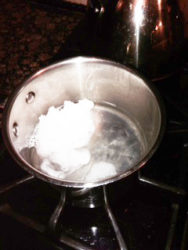
When the mixture is totally blended, pour into your greased lasagna pan.
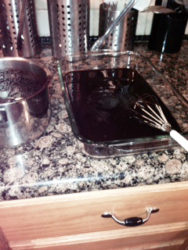
pour into lasagna pan
Put into the refrigerator to cool. (Its’ right in front of the milk.) (Notice all the veggies and fruit in my refrigerator.)
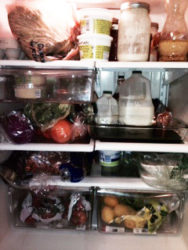
Carob bar pan in refrigerator.
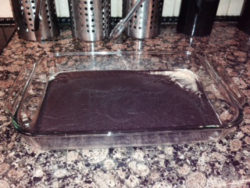
Warming up a bit from the refrigerator.
After at least an hour, remove from refrigerator and let return to closer to room temperature before cutting into squares.
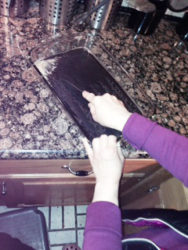
Cutting into squares.
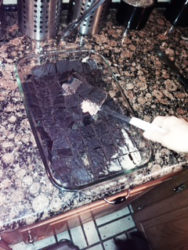
Metal spatula removes squares.
I prefer to eat my carob bars cold, directly from the refrigerator. When I take them to work, I pack a freezer pack with it. It doesn’t taste as good warm…and the coconut oil gets mushy at room temperature. Â That said, I’ve had regular civilians (company who are NOT into natural health!) enjoy these bars when served cold along with walnuts or almonds.
Options:
You could make them with chopped nuts inside. You could eat them frozen. (But be careful, I nearly chipped a tooth trying that; hubby has stronger teeth–no problem for him.)
Conclusion: These are a tasty, delicious dessert for those who have been dessert deprived (like me). I love them!!! I eat six to eight 1-inch bars each day. (They are about a quarter-inch thick. Sorry, I don’t know metrics, so please convert if you’re not from the US.) If you decide to give this a try, let me know what you think.
Wishing you healthy thoughts and life! – Denise
8 Responses to "Carob-Coconut Oil Bars for CLL"
2 | Den
February 6, 2018 at 11:31 pm
Save yourself a lot time and effort and buy some silicon chocolate molds. Carob chocs slip from them easily after around 10 mins in fridge or freezer. Plus they look attractive!
Denise
February 7, 2018 at 3:18 pm
That is a great idea! Unfortunately, I’ve recently discovered that carob is high in oxalates (oxalates could be a whole ‘nother book, let alone a post on this site). But for many reasons, I’ve had to give up my precious carob. (I’ve been in mourning about this, believe me!) However, your mold idea sounds perfect, particularly because this is a refrigerated (rather than a baked) dessert/treat, so no need to worry about the effects of heated silicon by your food. (I worry about such things.) Thank you for your suggestion! I’m currently working on low-oxalate/gluten-free cookies — a challenge! If I come up with a solution, I will post about it. I may have the CLL diagnosis, but I like to eat! Desserts, too!)
Thanks for writing!!! – Denise
Lori
September 10, 2020 at 8:27 pm
In my research, I have found that cocoa is high in oxalates. Carob has no oxalates. Just thinking maybe you didn’t need to give up carob bars after all? I am curious to what other foods you eat to help keep weight on? Keeping weight on has been an uphill battle for me. There just isn’t enough calories in meat and veggies and I always am still hungry. I can’t tell you the last time I actually felt full. Also, do you eat potatoes, corn, carrots, peas, beets? What about dairy foods but not regular milk like real butter, cream cheese, cottage cheese, sour cream, any cheese? Nuts? I realize what is okay for one may not be okay for another, but I wonder what other options there are other than just meat and veggies that I may be able to test out that you eat that doesn’t affect your wbc. Maybe if not too much of a problem, you wouldn’t mind giving a run down of a typical day or two (or three ) of what foods you eat. I would really appreciate it and I’m sure others would find it helpful.
Denise
September 10, 2020 at 8:50 pm
Thanks for writing, and you pose very good questions. First, about the oxalates…going low oxalate (since 1997!) has been the hardest part of my dietary changes. It’s easier do know how to cut out dairy or gluten (I’ve done both) than it is to cut out oxalates. For one thing, there are different lists and conflicting oxalate level reports for the same food items (sigh) making it very difficult. I did have carob for years, thinking it was low oxalate. However, more recent tests I’ve found place it also in the high category. Darn! I hate it when my go-to substitute foods are a problem.
Okay, I rarely eat potatoes, corn or peas. And I never eat cheese or any dairy (I miss it, but I definitely react, so off my diet list.) And I don’t eat many nuts, because they, too, have high oxalates. All this, and unlike you, I struggle to not gain weight. So, here is what I do eat, fairly regularly:
slow-cooked chicken, beef, white fish, tuna, sardines
lots of veggies (but not the high oxalate choices)
fruit – apples, nectarines, blueberries, cherries, grapes, some strawberries (too many strawberries become high oxalate), organic apple sauce unsweetened
white rice (brown rice is high oxalate)
macadamia nuts, pumpkin seeds, sunflower seeds
If you’re trying to gain weight, have some sunflower seed butter, available in organic, although I used to have the conventional. I plump up with that. I used to eat rice cakes, but that also puts the weight on for me.
I make home made dressings to make food more interesting. Olive oil and ACV (apple cider vinegar) along with seasonings, lemon juice, fresh squeezed garlic, sometimes Eden brand ume plum vinegar. I switch out the ingredients each time I make it. Olive oil and a vinegar are always the base.
I did have just the meat and veggies for a long time, and it does get BORING. So experiment with adding foods and see how you feel, and also make note of your changes and see how your test results are after a time.
Just a note…eggs have been my go-to fast food, and as I write I’ve been cutting them out for about four days so far to see if this has anything to do with my chronic throat congestion/post-nasal drip. I was advised to cut it out after a blood sample test, but was reluctant as I felt my diet was already so narrow. But I’m testing it out, and this morning I woke up better able to breathe than usual. So. If I continue to get better and able to stop having to clear my throat, I guess eggs will go the way of dairy (and gluten, and oxalates). It will be worth it, if so, and I will adjust. I love eating, just like anyone else, but living and feeling well are more important to me.
If I were you, I’d go out and buy some rice cakes and sunflower seed butter. The wild rice cakes are lower in oxalates. And it is delicious – and fattening. Have a blast! 🙂 Please check back in and let me know how you’re doing. All best, Denise
Udi’s gluten free bread (more often than I should; I need some “guilty pleasures.”)
3 | Henry
September 1, 2016 at 4:37 pm
Like you I have avoided sugars of all kind. Even gave up my beloved Animal Crackers. I made this yesterday and LOVED it. In fact I ate too much and have paid the price, oil being what it is. Thank you for sharing.
4 | Jennifer
June 5, 2016 at 9:32 am
Absolutely scrummy Denise! Wish you hadn’t told me though, hard to stop eating them Lol! So easy to make and allows one a little treat. Thank you…
Jennifer
Denise
June 24, 2016 at 3:27 pm
Thanks, Jennifer! Glad you enjoyed them. They are healthy, but if you have too many you can overload on the fat (which can make for stomach distress) and worse : ) could possibly cause weight gain. But still, these are healthy to eat and enjoy every day and very easy to make. Thanks for writing!
Leave a Reply
Tags
Get a free blog at WordPress.com
Albeo theme by Design Disease
April 5, 2018 at 8:36 pm
I have these chilling for my husband. He was recently diagnosed with CLL. As we are waiting on further testing I have been pouring over CLL support boards trying to learn all I can about it and about healthier foods that can help him. Thank you for posting your recioe for us to try.